Menu
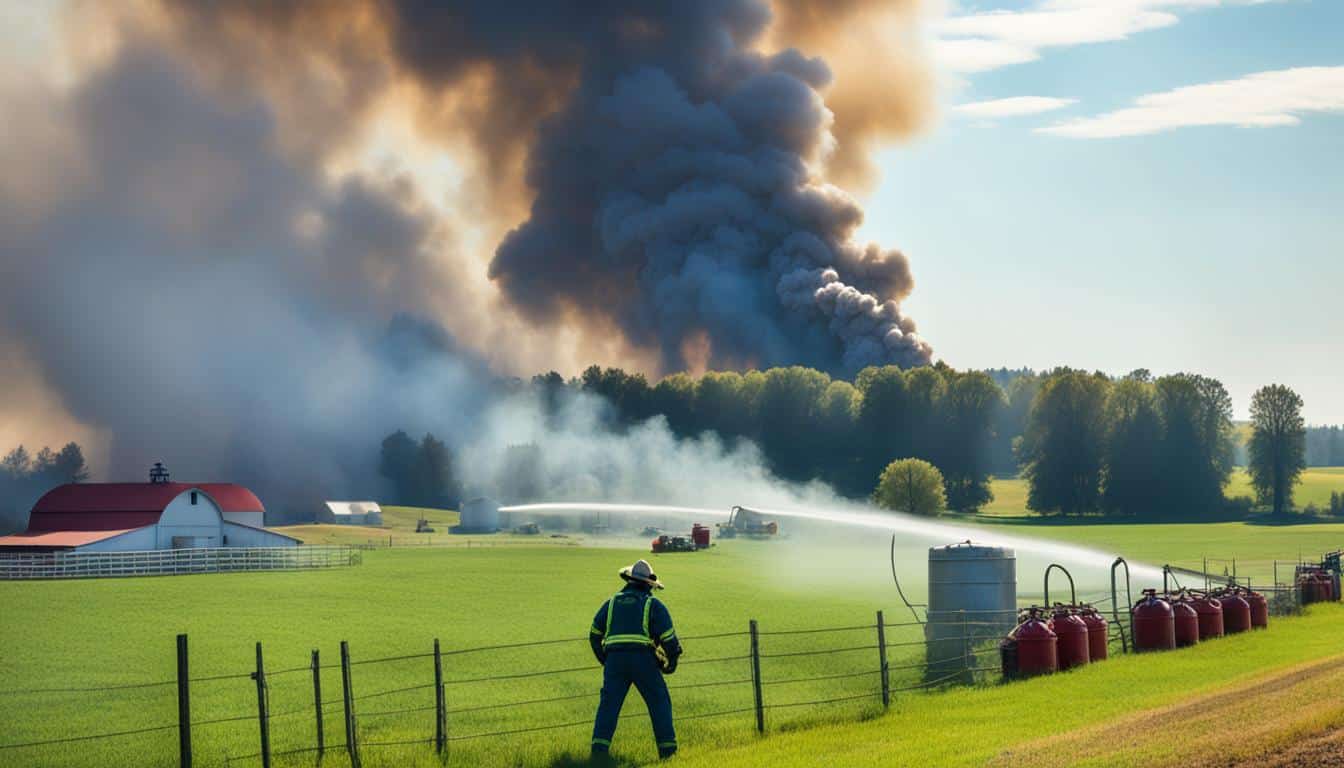
From 2013 to 2017, the United States saw 326 deadly barn fires each year. These fires caused one civilian death, and ten injuries. They also left behind $28 million in property damage. This highlights the pressing need for farm and agribusiness owners to focus on fire safety.
Owners need to look for fire risks and make a strong fire safety plan. It’s vital to know how to quickly call for help and guide emergency services to the farm. Put clear visible address numbers and share a Pre-Plan Data Sheet with neighbours and the fire department. Fires can grow uncontrollably in less than five minutes, usually at night or early morning.
It is key to prevent fires in agriculture. It’s crucial that both animals and people stay safe in a fire. Plus, companies might lower insurance costs for those who go the extra mile on fire safety. This adds to a thorough farm fire risk management.
It’s vital to understand the risks farm buildings face from fires. This helps keep the structures safe and minimises the damage from fires, especially in barns. Barn fires can burn down the whole building and cause heavy losses.
Most barn fires start with heating tools, mainly heat lamps. If not used or checked properly, they can start fires easily. They often set fire to hay and bedding quickly. Things like gasoline, kerosene, oil, and aerosols make this danger even bigger. Things like cigarettes, sparks, and faulty electrical gear can also start barn fires.
Older electrical systems can start fires too. Good safety for these systems includes putting the panel box in dry spots, using durable materials for boxes, and protecting wires in metal pipes. Making sure appliances have the UL stamp helps lower the fire risk.
Bigger risks of farm fires happen in summer and winter, when heating tools get a lot of use. During 2013-2017 in the U.S., there were 326 fatal barn fires. This led to a civilian death, ten injuries every year, and about $28 million in damage.
Places far from cities might face more dangers because help takes longer to arrive. Farms can avoid big fires by improving their fire plans, doing regular checks, keeping flammable stuff safe, and focusing on preventing fires.
It’s vital to have a fire safety plan for your farm. This is to reduce risks from materials that can catch fire and faulty machines. Farm fires often happen at night or early morning. So, being ready to act fast is a must. By following farm fire safety regulations, you can lessen the damage from such events.
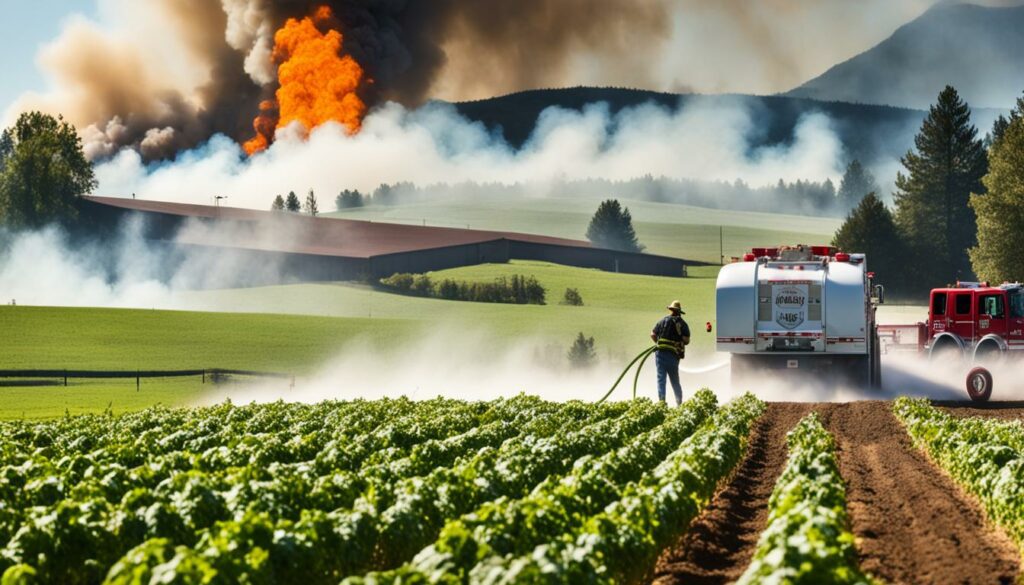
Spotting and cutting down on dangers is key for farm fire emergency preparedness. Issues like bad fuel systems, smoking near flammable stuff, and engines that get too hot are big risks. Checking machines often can stop these problems. Plus, make sure there are fire extinguishers on tractors and other gear to stay safe.
Creating a solid fire safety plan means making clear paths to leave, setting up safe spots for animals if you have to leave, and keeping up with their health info. Make sure everyone knows the plan well and work closely with your local fire department. This helps everyone get to know your farm and how to handle dangers, which is key for farm fire emergency preparedness.
| Statistic | Details |
|---|---|
| Barn Fire Damage | Half of all barn structure fires involve the entire building. |
| Fire Response Time | A barn can be fully engulfed in flames in less than 5 minutes. |
| Primary Fire Cause | Heating equipment is the leading cause of fires in farm buildings. |
Keeping the farm safe from fires is vital. The National Fire Protection Association (NFPA) tells us that 326 barn fires were deadly each year from 2013 to 2017. These fires led to a lot of loss. So, using the best fire prevention methods is key for all farm owners.
Strict NO SMOKING rules are very important on the farm. Smoking materials are common reasons for fires. Also, making sure engines and machines work well cuts the risk of fires from problems like overheating.
It’s also crucial to store flammable materials safely. Keep substances like gasoline and kerosene in special areas, far from things that could start a fire. Less dust near electrical parts and machines is another way to stay safe.
It’s smart to have space around heaters and to check them often. Heat lamps are the number one cause of barn fires. This shows we must inspect heaters and put them in the right way.
For emergency generators, they must run in places with good air flow. Keep generators away from things that might cause a fire. This, alongside using farm fire suppression equipment like alarms and sprinklers, helps lower the fire risk.
| Preventive Measure | Benefit |
|---|---|
| NO SMOKING Policy | Eliminates common ignition sources |
| Maintenance of Machinery | Prevents overheating and malfunctions |
| Proper Storage of Flammables | Reduces risk of accidental fires |
| Clearance Around Heaters | Reduces heating equipment fires |
| Ventilated Generators | Prevents buildup of flammable gases |
Using these fire safety steps makes the farm a safer place. It protects people and animals. Adding fire suppression gear like sprinklers and alarms, plus looking after everything well, creates a safe farming area.
It’s vital to keep farm buildings safe from fires to avoid big losses. One key point is making sure each building has at least two exits. This helps people and animals get out quickly and safely if there’s a fire.
Having more than one way out makes farm buildings safer if a fire starts. Owners need to keep these exits clear and easy to see. Each building should have two exits you can use easily at any time. Always check that they’re not blocked, especially in places like barns and storerooms where smoke can spread fast during a fire.
Using materials that slow down fires is a smart way to get ready for a wildfire. Buildings must have these special materials to lower the chance of fire spreading. For example, using fire-resistant wood, special insulation, and boards helps a lot, as studies show. This table explains how different materials can make farm buildings safer from fires:
| Building Component | Conventional Material | Flame Retardant Alternative | Fire Resistance Improvement |
|---|---|---|---|
| Insulation | Fibreglass | Non-combustible Foam | High |
| Roofing | Asphalt Shingles | Metal Roofing | Very High |
| Wall Assemblies | Standard Drywall | Fire-Resistant Gypsum Board | Moderate |
| Structural Framework | Standard Wood | Fire-Retardant Treated Lumber | Significant |
Also, keeping the area around the farm buildings clean can stop the fire from spreading. Storing dangerous stuff away from fire and making sure work areas have fresh air are very important. Always stick to a plan and check things regularly to keep the farm safe from fires.

Putting up lightning rods and using grounding cables stops lightning from starting fires. Keeping the place tidy and making sure things are put away properly are very important for farm fire safety. Always learning and following fire safety steps will keep the farm buildings strong and safe.
Keeping heating equipment safe is crucial on farms to prevent fires. Heat lamps are a big cause of barn fires. Thus, it is vital to check and maintain them often. Between 2013 and 2017, 326 barn fires happened, causing one death and ten injuries. Also, there was $28 million in property damage.
Farm owners need to be very careful about heating systems. They should make sure everything works well and is watched closely. This prevents equipment from getting too hot and breaking. Most barn fires happen in summer and winter, so farmers must be extra cautious then.
The table below shows key statistics about barn fires, highlighting why prevention is so important:
| Time Period | Number of Fires | Civilian Deaths | Direct Property Damage Annually |
|---|---|---|---|
| 2013-2017 | 326 | 1 | $28 million |
To manage fire risks, follow safe refuelling guidelines and ensure heaters have enough space around them. This keeps them away from things that can easily catch fire. It is important not to put heating equipment near substances that burn easily, like gasoline.
Farm buildings should have fire safety features like alarms and smoke detectors. These, together with keeping heating systems well-maintained, help prevent barn fires. This protects people and animals on the farm.
Keeping farms safe from electrical dangers is crucial to prevent fires and harm. It’s vital to check and keep up with the electrical systems to make farm electrical safety better. In this guide, I’ll discuss the steps farm owners need to take to stay safe and lower the risk.
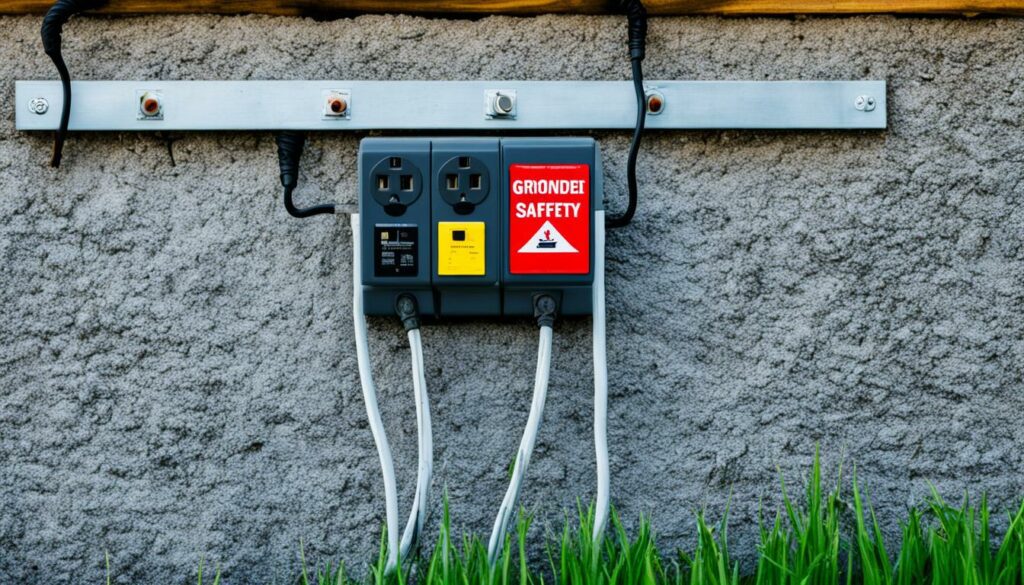
Around 30 to 40 people get electrocuted on farms every year. It’s important to understand the basics of electricity to keep everyone safe. Make sure your wiring, grounding, and tools are checked often by professionals. They must follow all the local or National Electric Code rules.
Good grounding helps stop electric shocks, fires, and damage to tools. Also, using lockouts can stop machines from turning on by mistake. This lowers the risk of getting hurt while fixing them.
Using and storing electrical gear the right way is key to prevent fires in the farm. Look out for damage in wires from animals or just from old age. Not doing these checks can lead to big dangers, like fires caused by electricity.
It’s a good idea to have GFCIs and clear labels on your electrical boxes. They help prevent shocks and make everything safer. Also, pick materials that resist corrosion and switches that are safe in tough conditions. This is important for farms in places where the weather can damage the electrical systems.
It’s vital to understand how electricity works around people. For example, even a bit of electricity from a small bulb can be deadly if it goes through the heart. Following these safety steps can make your farm’s electrical system safe and within the rules.
It’s vital to store flammable farm materials safely to avoid fire risks. By using the right methods, risks can be lowered. This protects the farm and the people on it.
Dealing with materials like gasoline, kerosene, and pesticides demands following strict safety rules. The National Fire Protection Association (NFPA) says barn fires lead to huge property damage. So, it’s key to follow the best procedures to avoid fires.
Having specific places for flammable items cuts down on fire risks. These areas need to be tidy and clearly marked. It’s crucial to abide by the maker’s advice and rules for these areas.
Insurance data shows barn fires are a year-round risk. In the summer, electrical storms and hot hay can catch fire on their own. In the winter, damaged wires or heaters might start a fire. Good storage helps lower these dangers.
Think about creating:
The National Fire Protection Association (NFPA) stresses non-combustible materials and tidy organisation in storerooms. Following these tips cuts the fire threat on farms.
In farm areas, it’s crucial to have a solid farm fire emergency plan. This plan should be detailed so everyone knows what to do in an emergency. Regular drills are a must. They help people get ready in case a fire happens. This plan must make sure people can easily talk to the police and get help quickly.
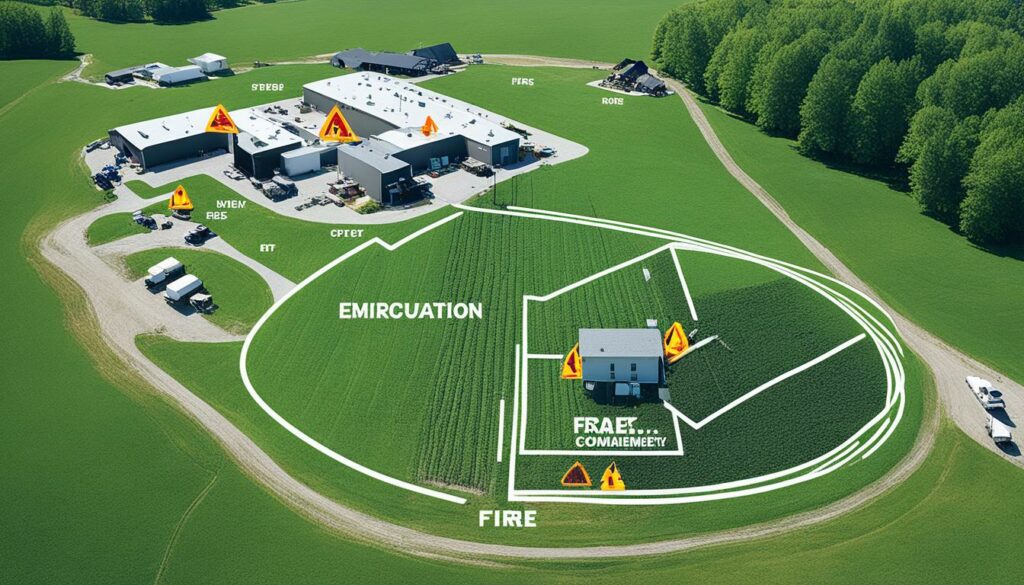
Having easy access for fire trucks is key. Farm fire responses require clear paths. Make sure buildings have open, wide lanes. These lanes need to be 20 feet across at least. Signs around the farm are also important for guiding firefighters to the fire quickly and safely.
Getting out safely is the top priority. Buildings should have many ways to get out, all easy to use. This makes it easier for people and animals to get away from danger. Train everyone to know the best ways to leave and where to meet up after they escape.
| Key Elements | Details |
|---|---|
| Carbon Monoxide Levels | High levels found in barn fires due to ventilation and burning. |
| Machinery Fires | Defects in fuel or starting systems can start big fires. |
| Fire Extinguishers | Farm shops need a wall-mounted 10-pound ABC fire extinguisher. |
| Electrical Malfunctions | Equipment fires can start from oil or electric problems. Always get equipment checked by a qualified electrician. |
| Emergency Lanes | 20 feet wide lanes around buildings help fire trucks get in easily. |
Being ready and planning carefully can lessen the damage from farm fires. Making sure everyone knows the farm fire emergency plan and having practice drills can really help. With these steps, farm owners can protect their farm, animals, and people.
Fire extinguishers are key for keeping farms safe from fires. They help react quickly if there’s a fire. This means less damage to the farm and fewer risks to people.
To keep the farm safe, it’s important to put fire extinguishers in the right places. Workers should also know how to use them. This keeps everyone prepared for any fires.
There are different fire extinguishers for different types of fires. For example, some are for wood fires, while others are for petrol fires. It’s vital to have the right one in various places around the farm. Areas like workshops and sheds, where there are flammable things, should have them close by.
Teaching staff how to use fire extinguishers is really important. They learn about different types of fires and how to tackle them. Regular training makes sure everyone knows what to do fast if a fire starts. They also learn the PASS technique.
Good training and placing fire extinguishers well are the foundation for farm safety. This, along with checking them every day and protecting risky areas, cuts the chance of serious fires.
Having the right fire suppression tools is key to protecting farms. The NFPA found that barn fires cost around $28 million in damage each year from 2013 to 2017. This highlights how crucial it is to have proper systems, technology, and alarms for fire safety.
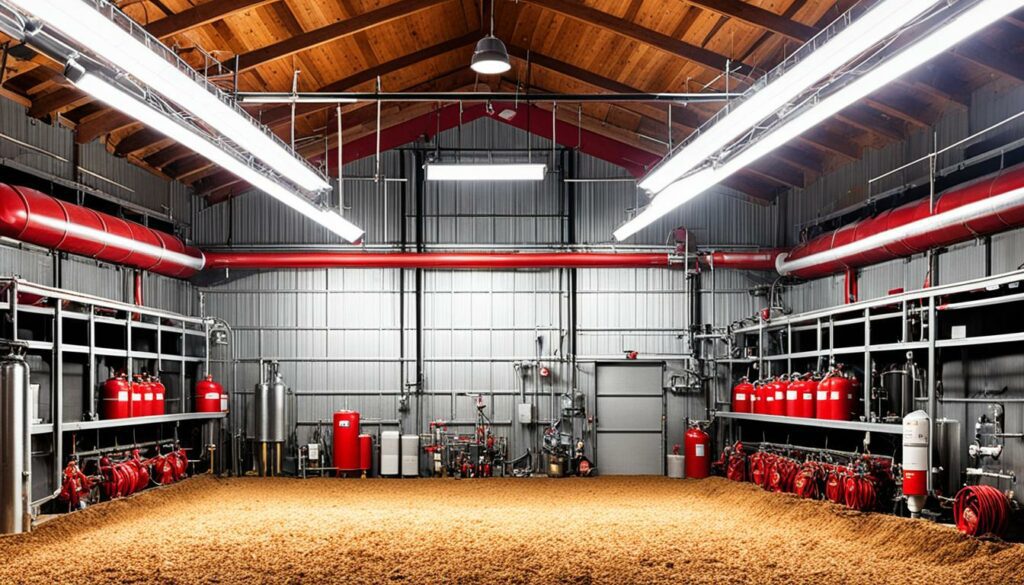
Fire sprinklers are vital for stopping fires in their tracks, offering a fast response. They manage the fire until help arrives. It’s important to check and look after them to make sure they work. Putting sprinklers in important areas helps reduce fire damage.
Smoke alarms are also very important for spotting fires early. Putting them in barns and key parts of the farm can warn people fast. Smoke alarms should be tested and have their batteries changed often. Using advanced technology that links smoke alarms makes the farm safer.
| Cause | Proportion of Fires | Solutions |
|---|---|---|
| Heating Equipment | Leading cause | Regular inspections, proper clearance |
| Electrical Issues | Significant risk | Regular maintenance, corrosion-resistant installations |
| Improper Storage | High accelerant risk | Correct labelling and designated areas |
Teaching people about how to use and take care of these systems is very important. Everyone on the farm should know how to use and take care of fire suppression systems. Doing this, along with using the latest in fire safety tech, helps prevent big losses from fires.
Ensuring emergency access for firefighting is vital on farms. It’s crucial to keep paths clear for vehicles. This helps fire departments reach every corner quickly. Make sure roads and yard areas are not blocked. Also, gates must be big enough for fire trucks.
It’s also key to have water available all the time. Set up many water points around the farm. Include safety features like marked hydrants and fire ponds. These steps make fighting fires easier if one breaks out.
Having emergency access for firefighting is life-saving. The farm should have signs that point to important places. This ensures fire trucks can get through easily. Such planning can reduce damage and save lives.
| Parameter | Recommendation |
|---|---|
| Roadway Clearance | Ensure a minimum of 3 meters for easy vehicle passage. |
| Gate Size | Minimum width of 3.5 meters to accommodate fire trucks. |
| Water Points | Strategically place water tanks or ponds within 500 meters of all farm structures. |
| Signage | Clearly marked routes and water points for emergency teams. |
Following these points ensures farm infrastructure safety. It makes the farm safer for people and animals. This also cuts the danger of big losses in a fire.
Setting up wildfire defensible space is a top-notch way to protect homes from wildfires. The area within five feet of a building is crucial, as flying embers often start fires here. We reduce the risk by clearing this zone of flammable items and plants.
Different places, like California, have their own rules for defensible space. San Diego County says you need 50 feet clear in Zone 1. A state law called Public Resources Code (PRC) 4291 asks for 100 feet of protected area around buildings.
Clear rules help keep the right space between plants.
, advice changes depending on the slope and the height of the plants. On flat ground, leave as much space as the plant’s height.
but on steep slopes, increase the space to six times the height.
For trees, place them farther apart as the land gets steeper. For example, trees on flat areas need 10 feet between them. But on steep ground, give them 30 feet of space.

If you’re doing any landscaping, do it before 10 a.m. and when it’s not too hot or windy. For cutting plants near buildings, use a string trimmer. It’s safer than a lawnmower.
Remove dead plants during droughts, even if you can do very little watering. This meets structural fire prevention advice. Join the National Firewise USA programme for more ways to stay safe in high-risk zones.
Putting trees in smart places and using firebreaks makes farms safer from wildfires. Following these steps increases a farm’s ability to fight off fires.
Understanding farm wildfire mitigation is crucial for farm owners. We should look at the land’s shape, access to roads, and water sources. Creating a solid wildfire emergency response planning strategy is key to protecting the farm.
To get ready for wildfires, first, check the farm’s layout. Look closely at ground shape, road access, and where the water is. It’s important to know if your farm is at risk and how to make it safer.
Having a good wildfire response plan is very important. This plan must cover:
Putting these farm wildfire mitigation ideas into action and having a specific wildfire emergency response planning plan will make our farms more resistant to wildfires.
| Recommendation | Details |
|---|---|
| Controlled Burns | Conducted under suitable conditions and permits. |
| Fuel Breaks | Regularly mowed or grazed strips of land. |
| Agroforestry Buffers | Creating windbreaks and enhancing local biodiversity. |
| Composting Practices | Improving soil moisture and water-retention capacity. |
Keeping farm machinery safe is key to avoiding fires. Always check your machinery well. Starting your day with a good look at your equipment can stop fires before they start.
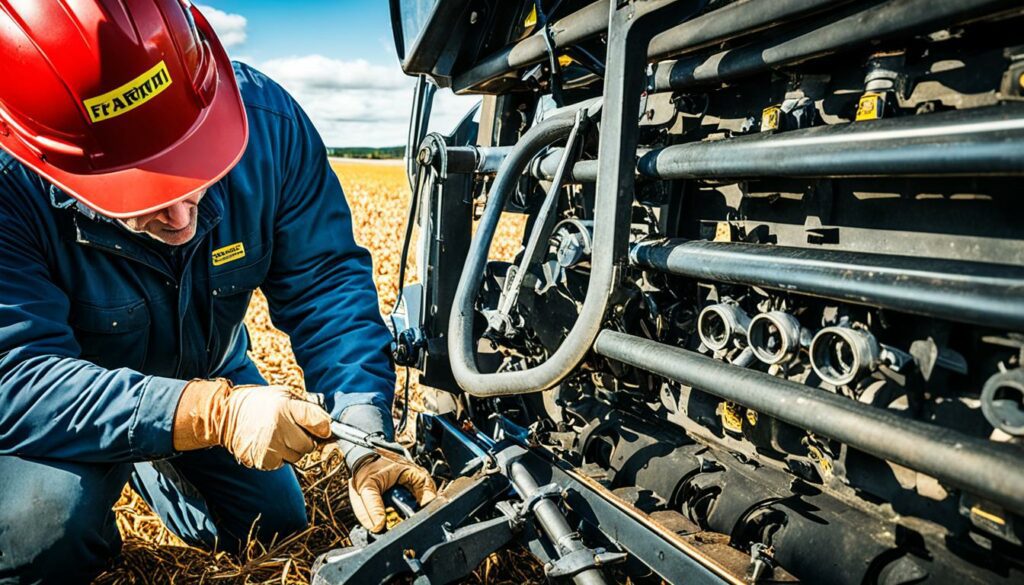
Many things can cause machinery to catch fire. These include problems with fuel or ignition, engines getting too hot, and sparks from parts rubbing together. To lower the risk of fire, make sure machinery is in top shape and refuel it right.
The danger is higher during busy times, when safety might be forgotten. But it’s important to be careful when handling fuel, such as gasoline and diesel. Use the right containers and keep them well away from anything that can cause sparks.
Don’t forget about rodents. They can chew on wires, starting fires. Stop them by using products to keep them away. Also, only let qualified electricians fix or install electrical equipment. This keeps things safe.
Every farm vehicle must have a fire extinguisher. Choose the ABC type because it works on all sorts of fires. Check them every year to make sure they work. Have a big fire extinguisher in the farm shop.
Understanding how to act fast in case of a fire is crucial. Here are some important steps to take:
| Main Cause | Prevention | Best Practice |
|---|---|---|
| Fuel System Defects | Regular Inspection | Daily Visual and Physical Checks |
| Overheating Engines | Adequate Cooling | Monitor and Address Engine Heat During Operations |
| Sparks from Exhaust and Friction | Spark Arresters | Install and Maintain Spark Arresters |
| Improper Refuelling | Safe Refuelling Stations | Refuel in Designated Areas Away from Ignition Sources |
Keeping machinery safe is crucial to avoid farm fires. Through careful inspection, following safety guidelines, and being prepared, the risk of fires can be lowered significantly.
Making sure a farm is tough in emergencies needs careful employee fire safety training and a clear farm communication strategy. These parts are key to lower risks and quick, united responses.
Fire drills are key to keep workers ready. These drills teach how to use firefighting gear, know escape plans, and talk after evacuation. Everyone should learn how to use tools like shovels and fire extinguishers. It’s smart to check fire plans often, especially before fire season starts.
A solid farm communication strategy is vital, especially when fast action is needed. This plan must have easy ways to report, names of emergency contacts, and ways to spread info fast. It also links with the farm’s emergency plan. This helps every worker know what to do if there’s a fire.
Making a good farm communication plan includes a detailed farm map. This map shows important places like homes, barns, shutoffs, power lines, and water. It should be easy to read and given to workers and local emergency teams. That way, everyone can act quicker in an emergency.
By spending on employee fire safety training and a good farm communication strategy, farm bosses make their places safer and tougher. This cuts down on losses from fires a lot.
In conclusion, a full-on approach to farm fire prevention and response planning is crucial. We need to watch out for many fire risks, like faulty electricals and things that can burn in barns. By doing so, we cut down on huge fires that can destroy buildings and harm animals.
It’s key to put in place safety steps. This includes keeping flammable items in special fireproof places and using safe electricals. Avoiding dangerous lights and picking strong materials for buildings also helps a lot.
Plus, having clear plans for getting everyone, including animals, out safely is very important. Using fire alarms, sprinklers, and the right extinguishers makes us ready for fires. Training and keeping up a strong safety focus are also vital. These steps strengthen our farms, making them safer and more able to bounce back from tough times.
Heating equipment is the main reason for fires in farm buildings. Other causes are fuel system issues, engines getting too hot, and sparks from exhausts. Electrical faults and storing flammable items wrong also lead to fires.
Farm fires are most common in late winter and early spring. This is when farmers are most active, preparing for the growing season. The extra use of equipment during this time is a major factor.
A good fire safety plan must spot risks and set clear escape routes. It needs to plan for where to house animals if needed. Keeping health records up to date is also important.
Regular checks with everyone on the farm help keep the plan fresh. Knowing your local fire services and them knowing your farm layout is crucial. They should be aware of possible dangers.
Make sure all buildings have two ways out and use materials that help prevent fires. Keep the area around your buildings clean and tidy. This lessens the risk of fires starting.
Putting up lightning rods, checking them, and keeping up with cables also helps. It stops lightning and electric faults from causing fires.
To stop fires, have ‘NO SMOKING’ rules and look after your machines well. Store flammable things properly. There should be enough space around heaters.
Keep emergency generators in places where there’s good air flow and no sparks.
Keep heating systems in good shape and make sure they work correctly. Follow safe practices when refuelling and keep combustibles away from heaters.
This care is key to stop fires.
Check and look after the electrical systems often, following expert standards. Store and use electrical gear the right way. Outlets should be safe and easy to find.
Labelling electric panels clearly and using covered outlets adds another layer of safety.
Keep things like gasoline in specific spots, in the right containers. Always check gas cylinders as advised by the maker. This keeps you and your farm safe.
A good fire plan has clear steps for all, including how to contact local help. It involves regular practice and making sure paths for rescue services are easy to get to.
Having signs and removing obstacles for help when needed are part of the plan.
Put the right fire extinguishers in places where they can be swiftly used. Make sure everyone knows how to use them. This is vital to fight fires fast.
Smoke detectors and sprinklers are essential for spotting and stopping fires early. Keep them in good condition. Educate all about their upkeep to avoid fire damages.
Clear roads, spacious gateways, and water access all year-round help firefighters. Making sure they can reach any part of your farm is critical in an emergency.
To make a safe space around buildings, clear away things that burn easily. Plant fire-resistant trees and make firebreaks. This protects your farm from spreading fires.
Study the area, access, and water, and make a plan to fight wildfires. Know when to leave and how to protect your assets. Design your farm to stop fire spread.
Test machinery often, fuel them safely, and have fire extinguishers ready. Stop rodents and follow safety guidelines, especially on risky days. This is crucial for safety.
Do fire drills and teach everyone about fire safety. Have a clear plan for communication in emergencies. Make sure all know who and how to call for help.